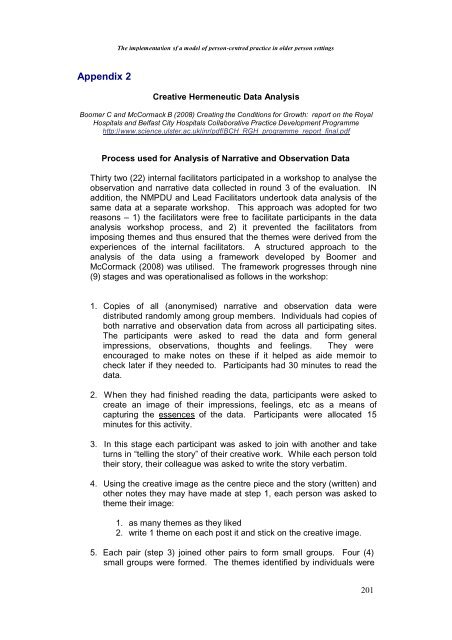The Implementation of a Model of Person-Centred Practice In Older ...
The Implementation of a Model of Person-Centred Practice In Older ...
The Implementation of a Model of Person-Centred Practice In Older ...
Create successful ePaper yourself
Turn your PDF publications into a flip-book with our unique Google optimized e-Paper software.
<strong>The</strong> implementation <strong>of</strong> a model <strong>of</strong> person-centred practice in older person settings<br />
Appendix 2<br />
Creative Hermeneutic Data Analysis<br />
Boomer C and McCormack B (2008) Creating the Conditions for Growth: report on the Royal<br />
Hospitals and Belfast City Hospitals Collaborative <strong>Practice</strong> Development Programme<br />
http://www.science.ulster.ac.uk/inr/pdf/BCH_RGH_programme_report_final.pdf<br />
Process used for Analysis <strong>of</strong> Narrative and Observation Data<br />
Thirty two (22) internal facilitators participated in a workshop to analyse the<br />
observation and narrative data collected in round 3 <strong>of</strong> the evaluation. IN<br />
addition, the NMPDU and Lead Facilitators undertook data analysis <strong>of</strong> the<br />
same data at a separate workshop. This approach was adopted for two<br />
reasons – 1) the facilitators were free to facilitate participants in the data<br />
analysis workshop process, and 2) it prevented the facilitators from<br />
imposing themes and thus ensured that the themes were derived from the<br />
experiences <strong>of</strong> the internal facilitators. A structured approach to the<br />
analysis <strong>of</strong> the data using a framework developed by Boomer and<br />
McCormack (2008) was utilised. <strong>The</strong> framework progresses through nine<br />
(9) stages and was operationalised as follows in the workshop:<br />
1. Copies <strong>of</strong> all (anonymised) narrative and observation data were<br />
distributed randomly among group members. <strong>In</strong>dividuals had copies <strong>of</strong><br />
both narrative and observation data from across all participating sites.<br />
<strong>The</strong> participants were asked to read the data and form general<br />
impressions, observations, thoughts and feelings. <strong>The</strong>y were<br />
encouraged to make notes on these if it helped as aide memoir to<br />
check later if they needed to. Participants had 30 minutes to read the<br />
data.<br />
2. When they had finished reading the data, participants were asked to<br />
create an image <strong>of</strong> their impressions, feelings, etc as a means <strong>of</strong><br />
capturing the essences <strong>of</strong> the data. Participants were allocated 15<br />
minutes for this activity.<br />
3. <strong>In</strong> this stage each participant was asked to join with another and take<br />
turns in “telling the story” <strong>of</strong> their creative work. While each person told<br />
their story, their colleague was asked to write the story verbatim.<br />
4. Using the creative image as the centre piece and the story (written) and<br />
other notes they may have made at step 1, each person was asked to<br />
theme their image:<br />
1. as many themes as they liked<br />
2. write 1 theme on each post it and stick on the creative image.<br />
5. Each pair (step 3) joined other pairs to form small groups. Four (4)<br />
small groups were formed. <strong>The</strong> themes identified by individuals were<br />
201
















